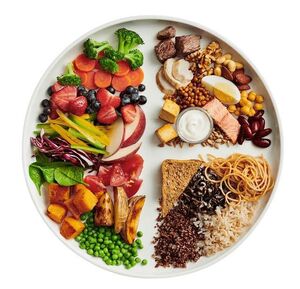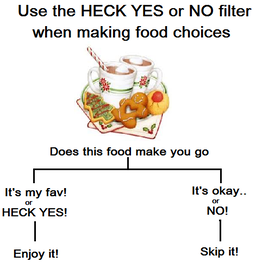|
Stephanie MacNeill, RD, MHSC, Sports Dietitian Many individuals feel like they have their nutrition under control, and then BAM, it’s the holiday season. The holiday season usually means lots of rich, sweet, and high fat foods that don’t necessarily fit with a healthful diet. One of the biggest problems for many people is the development of an all-or-nothing mindset. You’re either on track with your healthy eating efforts or you give up on them all together and get back on track when the New Year passes. This binary way of thinking doesn’t account for shades of grey, and can be responsible for a great deal of negative evaluation of yourself. The reality is, you can remove yourself from both of these categories, because it’s totally possible to stick to your healthy eating plan while fully enjoying the food and festivities this holiday season. Use these tips to help make the holiday season stress-free when it comes to food. 1. Balance your plate and make it colourful Create a balanced plate by filling 1/2 your plate with vegetables and fruit, 1/4 of your plate with whole grains, and the last 1/4 of your plate with lean protein. With vegetables and fruit, aim for colour and variety! And remember, potatoes don’t count as vegetables. Whole grains include whole wheat, barley, wheat berries, quinoa, oats, brown rice and foods made from them. Whole grains offer a “complete package” of health benefits, unlike refined grains, which are stripped of valuable nutrients during processing. Fish, poultry, and beans are all healthy, versatile protein sources—they can be mixed into salads, and pair well with vegetables on a plate. Limit red meat, and avoid processed meats such as bacon and sausage. 2. Be the one who brings the veggie/fruit tray Eating well comes down to colour: your plate should have less brown and white and more rainbow, especially orange and green. It's tough to make at least half your plate vegetables if there are no actual vegetables being served. So be the person that brings a fruit or veggie tray to the holiday gathering. That way you know there will be some colour at the party. If you’re feeling festive, you can make a holiday themed tray, or just bring a regular tray. And while we’re on the subject of vegetables, before you enjoy the roast turkey or savory stuffing, have a serving of the vegetable dish that you brought. This ensures that you actually eat the vegetables before getting too full. And because vegetables are high in vitamins, minerals, and fiber, it’s a great recipe for overall health. 3. Avoid skipping meals This is a popular strategy for holiday eating. Skipping breakfast and lunch in order to “save calories” for that extravagant holiday dinner. This may sound like a good idea, but it often leads to overeating. Instead, start the day with a balanced breakfast that includes some lean protein, complex carbohydrates and some colour (veggies and fruit). Then continue to eat consistently throughout the day like you would any other day. This will help to keep hunger and cravings in check so they don’t take over later at your holiday meal. 4. Rethink your drink Alcohol is served at many holiday events, but they can be a real hindrance when it comes to health and wellness. While one or two won’t make or break your diet, it’s easy to get carried away when you're in a celebratory mood. If you’re going to drink, try to alternate between water and alcohol to minimize your intake and to help you stay hydrated. Also consider using low-calorie mixers such as seltzer or tonic water as a mixer for hard liquor to help reduce added calories. 5. Use the heck yes or no filter Try using the ‘heck yes or no’ filter when making food choices over the holidays. How does it work? If there’s a food that you really want, and it’s only around this time of the year, then check the box for ‘heck yes’. For example, my mom usually makes a flourless chocolate cake a couple of times and year, so you can bet that I’m definitely having a piece!
On the other hand, if you’re on the fence about a food, and not really sure that you want it, just take a pass. Regardless of your food decision, remember that it’s your decision! Don’t feel pressure to have something just because everyone else is. And don’t feel guilty for having something that you really truly enjoy. 6. Utilize your hunger and fullness cues Try to eat intuitively and recognize when you are hungry and when you are full. When you are eating, make a point to pay attention to your food. Appreciate the different textures. How does your food smell? How does it taste? Chew well until you can taste the essence of the food. (about 15 to 30 times, depending on the food.) You may be surprised at all the flavours that are released. You mind just find that mindfulness helps you eat less. 7. Get moving You’ve got a lot on your plate this time of the year, and often physical activity can get passed over. But being active is your secret holiday weapon. Physical activity can help you decompress from the holiday stress and help maintain good health. So get moving with family and friends this holiday season. If you’re at a family gathering, suggest a walk before the feast or even between dinner and dessert. 8. Lose the guilt Holiday foods are part of your family tradition and culture and should be embraced and enjoyed. Do not feel guilt over enjoying these foods, they contribute to the memories that you will cherish from the season. For help getting your nutrition on the right track this holiday season, consider booking an appointment with a registered dietitian. Happy Holidays!
0 Comments
Your comment will be posted after it is approved.
Leave a Reply. |
Physio Sport Med
Serving all of Oakville in the Uptown / Dundas-Trafalgar Core. Archives
May 2025
Categories |
- Info
- Book Now
-
Team
-
How We Treat
- Sport Medicine Consultation
- Manual - Exercise Physio
- Sport Physiotherapy
- Tissue Injections
- Acupuncture
- Vestibular Physiotherapy
- Osteopathy
- Chiropractic Care
- Concussion Program
- Shockwave Therapy
- Female Pelvic Health
- Male Pelvic Health
- Registered Massage Therapy
- Nutrition Consultation
- On-Field Therapy Coverage
- Custom Orthotics
-
What We Treat
- Sports Injuries
- Low Back Pain
- Osteoarthritis
- Motor Vehicle Accident
- Sprains
- Muscle Strains
- Concussion
- Rotator Cuff
- Tendonitis
- Neck Pain and Headaches
- Hip Pain
- Shoulder Pain
- Elbow, Wrist and Hand Pain
- Foot and Ankle Pain
- Post Surgical Rehabilitation
- Gait and Balance Disorders
- Knee Injuries
- Pelvic Floor Conditions
- Blog




 RSS Feed
RSS Feed